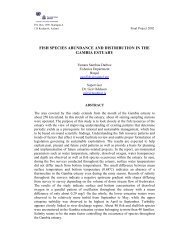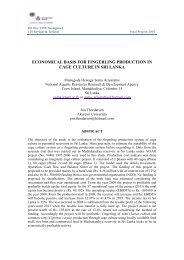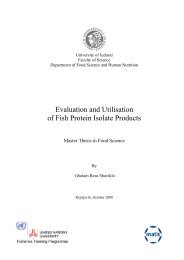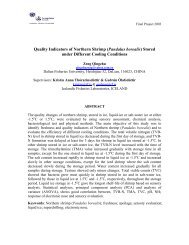a compliance study of Bangladesh shrimp aquaculture - The United ...
a compliance study of Bangladesh shrimp aquaculture - The United ...
a compliance study of Bangladesh shrimp aquaculture - The United ...
Create successful ePaper yourself
Turn your PDF publications into a flip-book with our unique Google optimized e-Paper software.
Seraj1 INTRODUCTION1.1 Background<strong>Bangladesh</strong> is a fortunate country in terms <strong>of</strong> soil fertility and water resources. It is located inthe North-Eastern part <strong>of</strong> South Asia between 20º34' and 26º36' north latitude and 88º01' and92º41' east longitude. Its land fertility and favourable tropical climate made favourableconditions for the production <strong>of</strong> various crops and thus the economy is based on agriculture.<strong>The</strong> diverse water resources led to fisheries being an important sector <strong>of</strong> the <strong>Bangladesh</strong>ieconomy. <strong>Bangladesh</strong> has many inland fresh water resources including hundreds <strong>of</strong>interconnected rivers and canals, oxbow lakes, lakes, reservoirs and seasonal flood-plainscovering over 4.0 million ha (Table 1). <strong>The</strong>se open, semi-closed or seasonal fresh waterresources provide suitable habitats for numerous wild fish and shellfish species. <strong>Bangladesh</strong>also has large marine and brackish water resources including coastal plains, tidal flats,estuaries and inshore and <strong>of</strong>fshore waters extending 714 km to the Bay <strong>of</strong> Bengal and anExclusive Economic Zone (EEZ) <strong>of</strong> 164,000 sq km which is not largely exploited yet (DoF,2007). <strong>The</strong> coastal zone features several natural mangrove forest ecosystems (eg. worldfamous Sundarbans mangrove) that support rich aquatic biodiversity.Table 1: Fisheries resources <strong>of</strong> <strong>Bangladesh</strong> and production during the period July 2006-June 2007 (DoF, 2008b).ResourcesInlandCaptureFisheriesRiver and estuaries (with Sunderbanscanals)Water Production inarea (ha) metric tonnes(mt)1,031,563 154,709Beels (large reservoirs) 114,161 75,137Kaptai lake 68,800 8,085Flood plain (Seasonal water area) 2,832,792 768,830Sub-total inland capture 4,047,316 1,006,761 41Aquaculture Ponds and ditches 305,025 811,954Baor (oxbow lakes) 5,488 4,698Shrimp farms 217,877 129,160Sub-total <strong>aquaculture</strong> 528,390 945,812 39Inland fisheries & Aquaculture total 4,575,706 1,952,573 80MarinecapturefisheriesIndustrial Fisheries (Trawl) 35,391(%) TotalproductionArtisanal Fisheries 452,047Sub-total Marine capture 487,438 20Country Total 2,440,011 100%Fisheries play a vital role in food supply, employment and foreign exchange earning <strong>of</strong><strong>Bangladesh</strong>. It is one <strong>of</strong> the most productive and dynamic sectors in <strong>Bangladesh</strong>. About 1.2million people are directly and 12 million people are indirectly involved in fisheries and<strong>aquaculture</strong> <strong>of</strong> <strong>Bangladesh</strong>. In the fiscal year 2007–2008 this sector contributed 60% <strong>of</strong>animal protein to the 142 million <strong>Bangladesh</strong>i citizens and 4.8% <strong>of</strong> total GDP <strong>of</strong> the country(BBS 2008).<strong>Bangladesh</strong>i fisheries and <strong>aquaculture</strong> are characterized by high species diversity. <strong>The</strong>re are260 freshwater and 475 marine fish species, 25 prawn and 36 <strong>shrimp</strong> species, 4 species <strong>of</strong>lobsters, several species <strong>of</strong> cephalopods, marine mammals and other wildlife species found inUNU-Fisheries Training Programme 1
















